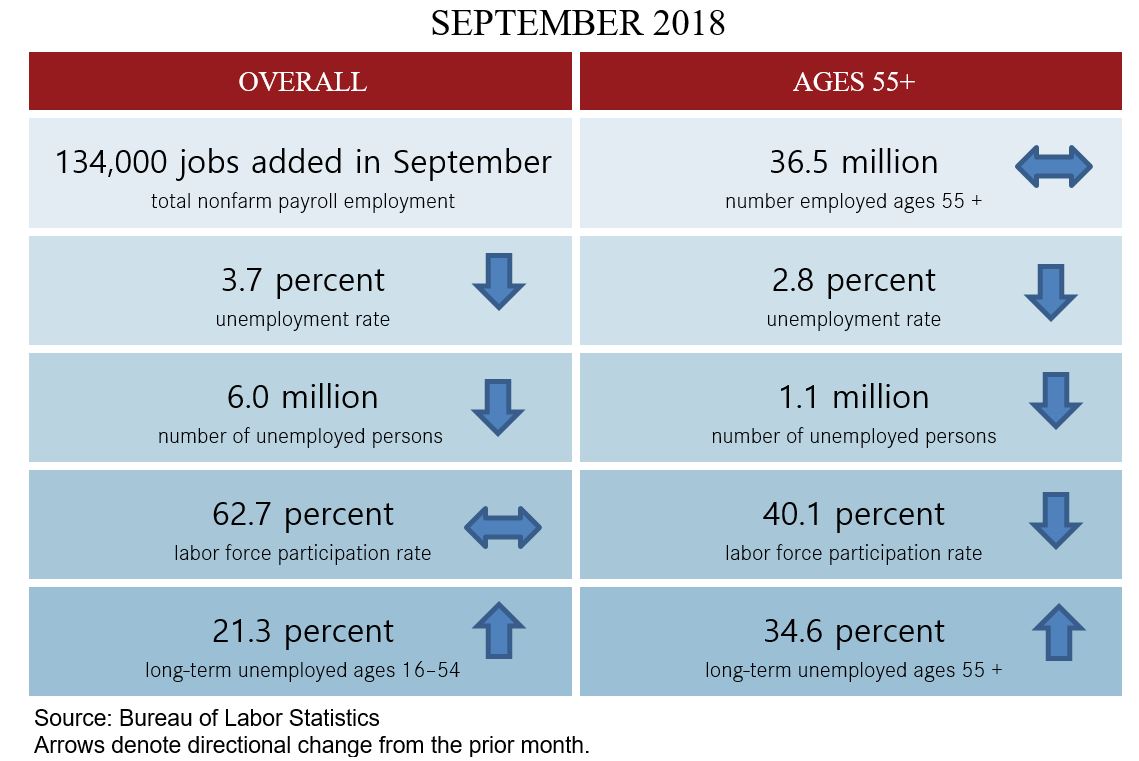AARP Hearing Center
Unemployment Falls to 3.7% in September
By Jennifer Schramm, October 5, 2018 05:20 PM

Employment Overview
Though the unemployment rate declined to 3.7 percent in September, job growth slowed compared with August, according to the Bureau of Labor Statistics’ (BLS) September Employment Situation Summary. Overall employment increased by 134,000 jobs compared with the 270,000 jobs added in August (revised up from 201,000). The professional and business services, health care, and transportation and warehousing industries all added jobs. The overall labor force participation rate remained at 62.7 percent but edged down slightly to 40.1 percent for those ages 55 and over. There were 6 million people unemployed, down from 6.2 million in August.
Meanwhile, the number of unemployed people ages 55 and older edged down to 1.1 million. The number of those ages 55+ who were employed was also unchanged at 36.5 million. While the unemployment rate for the 55+ declined to 2.8 percent, the percentage of long-term unemployed ages 55 and older increased to 34.6 percent.
Spotlight: Older Workers Less Likely to Be Reemployed after Job Displacement
The BLS recently released its data on displaced workers, defined as “persons 20 years of age and over who lost or left jobs because their plant or company closed or moved, there was insufficient work for them to do, or their position or shift was abolished.” From January 2015 through December 2017, there were 3.0 million workers displaced from jobs they had held for at least 3 years and an additional 3.8 million persons displaced from jobs they had held for less than 3 years. The number of long- and short-tenured displaced workers totaled 6.8 million, down from 7.4 million for the 2013-15 survey period. Fifty-seven percent of long-tenured displaced workers in the most recent survey did not receive written advance notice that their jobs would be terminated.
Compared with younger workers, those ages 55 and older who have experienced job displacement are less likely to be reemployed. Sixty percent of workers ages 55 to 64 and 31 percent of those ages 65+ who had lost their jobs during the survey reference period were reemployed by January 2018. This compares with 76 percent of workers ages 25 to 54 who were back at work. Over half (57 percent) of workers ages 65 and older who had been displaced had dropped out of the labor force entirely.
Analysis of other BLS data finds that older jobseekers are more likely than their younger counterparts to cite layoffs as their reason for unemployment, with unemployed individuals ages 65 and older more likely than any other age group to say that they are unemployed because they were laid off. Older jobseekers experience long-term unemployment more often than younger workers. Thus, their risk of dropping out of the labor market altogether is higher even though many may want to continue working.
As the workforce ages and policymakers look for ways to encourage longer working lives, they will need to focus on helping displaced workers find reemployment. Building a more robust system for reintegrating workers back into the labor market may involve expanding access to affordable lifelong learning and education, better evaluation of the efficacy of existing transition assistance programs, and broadening such programs to include a wider range of displaced workers such as those who have experienced job loss due to automation.
Find more details on the latest employment data in the September Employment Data Digest, PPI’s monthly review of job trends for those ages 55 and over.

Jen Schramm is a senior strategic policy advisor at the AARP Public Policy Institute. As part of the Financial Secu rity Team, she identifies policy challenges and opportunities related to workers ages 50 and above. Through resea rch and analyses of emerging employment trends, she develops policy options to inform AARP’s strategy on work and jobs, including helping older workers find and retain jobs.































































